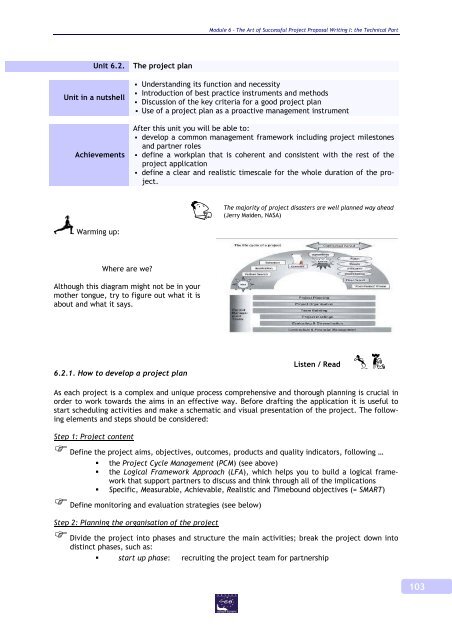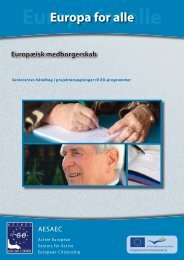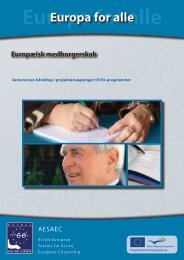We All are Europe - AESAEC
We All are Europe - AESAEC
We All are Europe - AESAEC
Create successful ePaper yourself
Turn your PDF publications into a flip-book with our unique Google optimized e-Paper software.
Module 6 – The Art of Successful Project Proposal Writing I: the Technical Part<br />
Unit 6.2.<br />
Unit in a nutshell<br />
Achievements<br />
The project plan<br />
Understanding its function and necessity<br />
Introduction of best practice instruments and methods<br />
Discussion of the key criteria for a good project plan<br />
Use of a project plan as a proactive management instrument<br />
After this unit you will be able to:<br />
develop a common management framework including project milestones<br />
and partner roles<br />
define a workplan that is coherent and consistent with the rest of the<br />
project application<br />
define a clear and realistic timescale for the whole duration of the project.<br />
The majority of project disasters <strong>are</strong> well planned way ahead<br />
(Jerry Maiden, NASA)<br />
Warming up:<br />
Where <strong>are</strong> we<br />
Although this diagram might not be in your<br />
mother tongue, try to figure out what it is<br />
about and what it says.<br />
6.2.1. How to develop a project plan<br />
Listen / Read<br />
As each project is a complex and unique process comprehensive and thorough planning is crucial in<br />
order to work towards the aims in an effective way. Before drafting the application it is useful to<br />
start scheduling activities and make a schematic and visual presentation of the project. The following<br />
elements and steps should be considered:<br />
Step 1: Project content<br />
Define the project aims, objectives, outcomes, products and quality indicators, following …<br />
the Project Cycle Management (PCM) (see above)<br />
the Logical Framework Approach (LFA), which helps you to build a logical framework<br />
that support partners to discuss and think through all of the implications<br />
Specific, Measurable, Achievable, Realistic and Timebound objectives (= SMART)<br />
Define monitoring and evaluation strategies (see below)<br />
Step 2: Planning the organisation of the project<br />
Divide the project into phases and structure the main activities; break the project down into<br />
distinct phases, such as:<br />
start up phase: recruiting the project team for partnership<br />
103









